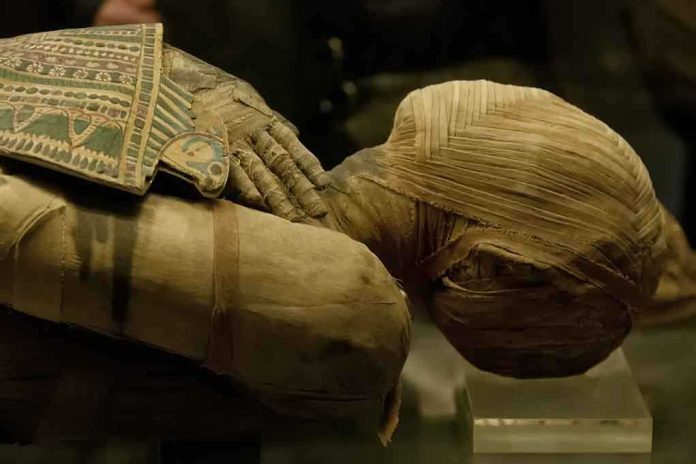
The world’s most famous tomb is teetering on the brink—Tutankhamun’s burial chamber may soon be lost forever, and the reasons behind its impending collapse are as complex as the ancient secrets it once guarded.
Story Snapshot
- Tutankhamun’s tomb faces its gravest structural threat since its discovery a century ago.
- Fractures, moisture infiltration, and fungal contamination accelerate its deterioration.
- Experts warn that immediate intervention is required to prevent catastrophic collapse.
- Failures in risk management and conservation threaten Egypt’s cultural legacy and tourism industry.
The Tomb That Changed History Is Now in Jeopardy
Howard Carter’s 1922 discovery of Tutankhamun’s tomb electrified the world. Hidden in Luxor’s Valley of the Kings, KV62 revealed dazzling treasures and pristine wall paintings, offering unmatched insight into Egypt’s golden age. Yet this same tomb now faces its most perilous moment. A major fracture has split the ceiling, secondary cracks spider across the walls, and the threat of total collapse looms larger than ever. What happened to this ancient marvel, and why have warnings gone unheeded?
After the tomb’s unsealing, exposure to humidity and human traffic started a slow decay. The real turning point came in 1994 when flash floods inundated the Valley of the Kings. Torrential rains raised humidity, deposited sediment, and unleashed a fungal outbreak that attacked the painted walls. The tomb’s construction in fragile Esna shale—a rock notorious for fissuring and moisture absorption—only increased its vulnerability. Since then, each year has brought new threats, yet decisive risk management remains elusive.
Structural Collapse Is No Longer a Distant Threat
Egyptian archaeologists now warn that the tomb is at its most fragile state since Carter’s discovery. Prof. Sayed Hemeda of Cairo University has sounded the alarm: moisture infiltration and temperature fluctuations have severely compromised the tomb’s integrity. Fungal contamination is eroding wall pigments, and a recent ceiling fracture has triggered fears of imminent collapse. Despite these red flags, authorities have yet to implement comprehensive preventive measures. Monitoring remains sporadic, and risk management is widely criticized as insufficient.
The Ministry of Antiquities, responsible for safeguarding Egypt’s treasures, faces increasing scrutiny. While academics and experts have pushed for urgent action—formation of a high-level committee, installation of temporary supports, and regulation of humidity—the government’s response has been slow. UNESCO, the international guardian of World Heritage sites, can pressure for reforms but relies on Egyptian cooperation. The result is a tense standoff between scientific urgency and bureaucratic inertia.
What’s at Stake for Egypt and the World
Should Tutankhamun’s tomb collapse, the loss would be incalculable. Decades of research, priceless artifacts, and historical wall art could vanish in an instant. Egypt’s tourism industry—already battered by global uncertainties—would suffer a severe blow, and the nation’s reputation for heritage management would take a hit on the world stage. The crisis also exposes systemic risks across the Valley of the Kings, where other tombs face similar threats from geology, climate, and conservation lapses.
Tutankhamun’s tomb at risk of collapse in most fragile state since its discovery 100 years ago
https://t.co/coUBsje4U8— Paul Quibell-smith 🔶 (@QuibellPaul) October 18, 2025
For Egyptians, the tomb’s fate is bound to cultural pride and identity. For archaeologists and historians, it is a living laboratory that continues to reveal the mysteries of the ancient world. For the global public, it’s a symbol of enduring fascination—a reminder of what’s lost when the guardians of history falter. As expert Emad Mahdi argues, only with specialized risk-monitoring and regular safety assessments can such disasters be averted. The clock is ticking, and every day lost brings the tomb closer to irreversible ruin.
Expert Calls for Action—But Will Anyone Listen?
Unanimity among Egyptian experts is rare, but on Tutankhamun’s tomb, the chorus is clear: this is an unprecedented crisis demanding immediate intervention. Peer-reviewed research and authoritative statements all point to the same conclusion—regulate humidity, reinforce the structure, and overhaul conservation protocols now. Yet the lack of a “culture of prevention” within Egypt’s heritage management has left the tomb exposed. Will international attention force overdue reforms, or will bureaucratic inertia win out?
The fate of Tutankhamun’s tomb is no longer a distant worry—it is a test of how the world values its past. As the fractures spread and the experts grow more vocal, the open question remains: will the powers that be act in time, or will one of history’s greatest legacies crumble before our eyes?













